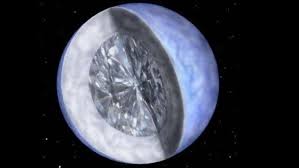55 Cancri, the diamond planet.
There is a huge number of planets in our universe. The number is beyond of our curiosity. Space science are discovering many planets everyday. Today we are going to learn about the 55 Cancri. New analysis suggests that a vast, star-scorched planet within the Cancer constellation, shortly from our scheme, is created in giant a part of diamonds, gap new vistas on the method scientists perceive however planets square measure created.
The planet, fifty five Cancri e, is double the scale of Earth then made in carbon that it holds a minimum of 3 times our planet's mass in diamonds, in step with a brand new paper that has been accepted for publication within the journal uranology Journal Letters.
On fifty five Cancri e, the surface is roofed in carbon, the dark stuff of pencils, with diamonds pushing through from layers beneath, aforesaid the paper's lead scientist, Nikku Madhusudhan, a fellow at Yale University's Center for uranology .
"We're talking a few rocky planet. Not abundant gas, virtually entirely solid. The outmost layer is at a particularly hot temperature ... There may even be a great deal of diamonds on the surface thanks to the geology movements within the interior. The diamonds may come back to the surface terribly simply," Dr. Madhusudhan aforesaid in AN interview.
"But just under the surface there's a really thick layer, a few third of the entire radius [of the planet], simply in diamonds."
That rocky, impressive world broils underneath a pair of,150C heat as a result of the earth is therefore getting ready to its star.
"There's not even a climate left. It's rubbed off by the warmth. it is a permanent barbecue," aforesaid author role player Mousis, a French stargazer at Université Delaware Franche-Comté.
The planet is that the nighest of 5 that orbit around fifty five Cancri A, a star situated forty light-weight years from Earth, shut enough that it will typically be seen with the optic.
"In uranology terms, it's like one in all our suburbs. It's nearer to North American nation than you and that i square measure on the phone," said Dr. Mousis, UN agency was speaking from his workplace in Besançon, close to the French-Swiss border.
The planet was detected in 2004 and its radius was calculable through transiting, which means that scientists deduced fifty five Cancri e's size by mensuration the decrease in luminance once the orbiting planet transited before of its star.
At first, researchers assumed that the planet's composition was the same as the world, with iron, silicates and water.
However, Dr. Madhusudhan aforesaid, that model did not properly work as a result of, to match fifty five Cancri e's mass, AN Earth-like model would needed a vast layer of water that might are in a very critical state, neither liquid nor gas, thanks to the acute conditions on the earth.
"That sort of rationalization wasn't adequate ... it absolutely was a vision that was too partisanship," Dr. Mousis aforesaid.
Their suspicions that another model ought to apply was additional supported once prism spectroscope information showed that fifty five Cancri e's star was additionally terribly made in carbon.
Presuming that the star and its planets were created from identical original chemical cloud, the researchers tested variety of chemical combos that would higher make a case for the planet's mass.
The carbon-rich situations work their calculations best, signalling a elementary shift within the method faraway planets ought to be analyzed, Dr. Madhusudhan aforesaid.
"When we tend to square measure searching for planets in outer star systems, we tend to currently need to be terribly open with regards to their chemistry. we tend to cannot presume that they're Earth-like."
Baking therefore getting ready to its star, fifty five Cancri e couldn't host life however Dr. Madhusudhan aforesaid its existence raised questions on alternative high-carbon, low-water planets.
"We need to be open with regards what reasonably biology may exist ... if we tend to had identical planet at a cooler temperature, the life forms there can be terribly totally different from what we all know. There would not be enough water or O for them to survive so that they would need to adapt to one thing else."
The researchers hope to realize higher insight on fifty five Cancri e with a lot of information from sources like the Edwin Hubble telescope, NASA's Spitzer area Telescope, that works within the spectrum, and also the Canada-France-Hawaii Telescope, that is run put together with the National analysis Council of Canada. Hope, this cotent give you enough knowledge about this amazing planet.









No comments